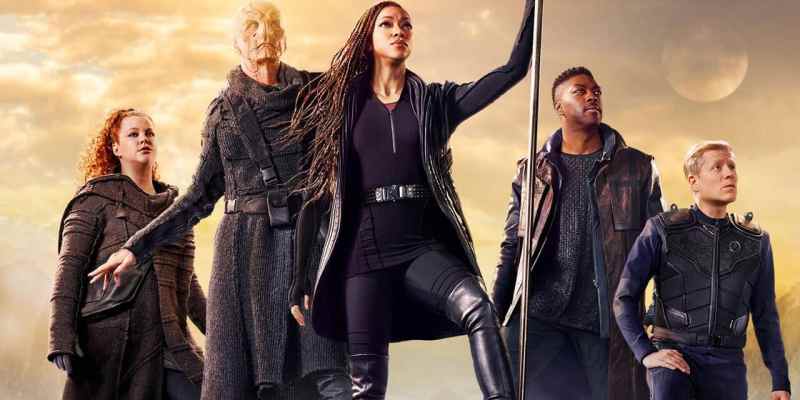In Star Trek VI: The Undiscovered Country, Klingon Chancellor Gorkon (David Warner) toasts “the undiscovered country: the future.” Despite his boasts that the crew of the Enterprise have not experienced Shakespeare until they “read him in the original Klingon,” it seems like something might have been lost in translation. Hamlet ruminates on death as “the undiscovered country,” not the future. In the third season premiere of Star Trek: Discovery, that circle is squared.
In “That Hope Is You, Part 1,” Michael Burnham (Sonequa Martin-Green) arrives in the distant 31st century to discover that the Federation no longer meaningfully exists. The Federation has long been synonymous with Star Trek, with Starfleet serving as the military and exploratory arm of the galactic union among a variety of races including humanity, the Vulcans, the Tellarites, and the Andorians. Every Star Trek show has been told from a Federation perspective. Even the prequel Enterprise explored the roots of the organization.
As such, the collapse of the Federation is a big deal in the world of Star Trek, particularly given that Starfleet and the Federation have long served as metaphors for American self-image. If James T. Kirk (William Shatner) can be seen as an analogue for President John F. Kennedy, with Kirk’s “final frontier” responding to Kennedy’s “new frontier,” then the Federation is an extrapolation of the myth of Kennedy’s “Camelot,” a romantic extension of American exceptionalism.
The “future within the future” in Star Trek particularly reflects the United States’ self-image. Star Trek: Voyager was set primarily in the 24th century but included glimpses of the 29th and 31st centuries. These futures were optimistic, suggesting business as usual. “Future’s End” and “Relativity” suggested that Starfleet was still operational in the 29th century. “Living Witness” confirmed the Delta Quadrant had not been swallowed by the Borg in the 31st century.

Voyager frequently allowed its characters to rewrite history without any significant consequence. In “Timeless,” a future version of Harry Kim (Garrett Wang) prevents the ship’s destruction. In the series finale “Endgame,” a future version of Kathryn Janeway (Kate Mulgrew) conspires to get the ship home 16 years early. Neither episode suggests that these changes will meaningfully rewrite the future. The future is so set in stone that it can withstand such tinkering.
This reflects Voyager as a product of the 1990s, the decade defined by the belief that the United States had won the Cold War and so reached “the end of history.” There was a belief that things were stable and sturdy and that they would remain that way. The future would be nothing but an extension of the present, with the security and comforts that it offered. No amount of tinkering with the timeline could change that; the future was fixed. The Federation and Starfleet would endure.
Deep Space Nine was less committed to this assurance, throwing Starfleet and the Federation into an existential struggle with the Dominion. However, it still took the survival of the Federation for granted. Starfleet endured in the grim future of “The Visitor.” When “Statistical Probabilities” suggested the possibility of loss, it predicted the rise of a stronger Federation. “Inter Arma Enim Silent Leges” revealed Federation operatives were already planning beyond the Dominion War.
However, things changed with Enterprise. The prequel series launched just weeks after 9/11 shattered the fantasy of “the end of history.” As a result, the utopian future of the Star Trek franchise was thrown into doubt. This played out in a number of interesting ways across the four seasons of the show, but most obviously in the “Temporal Cold War” that found various forces rewriting the past and future of the Star Trek universe.

“Cold Front” introduces Crewman Daniels (Matt Winston) as an operative from the distant future. In “Shockwave,” Daniels discovers that his future is in ruins – using imagery very evocative of Ground Zero. At various points over the course of Enterprise, there is tension and ambiguity about whether the utopian future portrayed in the earlier series can come to pass. The future is no longer certain. What little is seen of the future in episodes like “Azati Prime” suggests a galaxy in turmoil.
In the years following the end of Enterprise, Bryan Singer, Christopher McQuarrie, and Robert Meyer Burnett developed a pitch for a show called Star Trek: Federation that would have been set in the year 3000 and focused on a version of the Federation that was in decline. Around the same time, David Rossi, Doug Mirabello, and José Muñoz developed an animated pitch for a show called Star Trek: Final Frontier, which would also have seen a Federation in decline with the Vulcans seceding.
Even in contemporary Star Trek shows like Picard, there is a suggestion the Federation is no longer what it once was. When Jean-Luc Picard (Patrick Stewart) is asked to explain why he left Starfleet, he answers, “Because it wasn’t Starfleet anymore.” Picard repeatedly suggests the Federation has failed those to whom it owes an obligation: colonists in disputed space, refugees in need of assistance, synthetics in need of a future. It is no wonder Picard has to put together a team outside of Starfleet.
As such, the collapse of the Federation in the third season of Star Trek: Discovery seems an inevitability. Critics have observed that the premise recalls Gene Roddenberry’s original pitch for Andromeda, but Samantha Nelson very astutely points out a more contemporary parallel in the basic premise of The Mandalorian, with the lead character becoming a standard-bearer for a romantic worldview in a fallen world. (There are also shades of this in Raised by Wolves.)

This obviously reflects the current political moment. Patrick Stewart has not been shy in framing Picard as a response to Trump and Brexit. More broadly, the decline of the Federation within the Star Trek universe mirrors the decline in the international standing of the United States. The past few years have seen the collapse of the idea of the United States as a world leader, even if countries like Russia and China have yet to completely eclipse or replace it.
This gets at the tension within the stories about the Federation’s decline in Picard and Discovery. Both are quick to blame that decline on outside factors. In Picard, the Federation has been infiltrated by foreign operatives who have undermined it from within, serving as a metaphor for foreign interference in both the 2016 election and the Brexit referendum. In Discovery, the collapse of the Federation is due to “the Burn,” a natural disaster that may have a more sinister cause.
Neither Picard nor Discovery is entirely willing to turn its gaze inwards, to suggest that the collapse of Starfleet or the Federation might be down to systemic problems that require radical solutions. What if the systemic racism against synthetic lifeforms explored in The Next Generation and Voyager exposed a fundamental flaw in Starfleet? What if all those rogue and hawkish captains and admirals in Star Trek and The Next Generation were not aberrations, but expressions of a broken system?
The broken Federation of Picard and Discovery gestures at a very real crisis in contemporary American identity, but offers trite reassurance. At the end of Picard, William T. Riker (Jonathan Frakes) shows up out of nowhere with a fleet of Starfleet vessels to support his old captain and thus redeem the institutions of both Starfleet and the Federation, but how is that earned? How was the problem fixed, beyond the power of positive thinking?

Of course, Star Trek has a long history of bungling its metaphors in these ways, of identifying an underlying anxiety but refusing to follow it to its boldest conclusions. “Let That Be Your Last Battlefield” is a powerful allegory for the absurdity of racism, but it suggests that those opposing racism are just as responsible for social collapse as those perpetrating it. “Critical Care” is a critique of American healthcare that completely ignores how money is a decided factor in inequality.
This is arguably why Deep Space Nine has aged so well in comparison to its sibling. The show occasionally bristled with righteous anger at the franchise’s lack of introspection. The final season episode “Chimera” is a blistering condemnation of the franchise’s refusal to make room for actual queer characters within its supposedly utopian future outside of metaphors like “The Outcast” or “Rejoined.” It deservedly takes its Starfleet regulars to task for the franchise’s blind spot.
The original Star Trek offered a number of dark mirrors to the Federation, as if suggesting an alternate dark future for the United States. These mirrors were often evocative of Rome – the Terran Empire in “Mirror, Mirror,” the Romulans in “Balance of Terror,” even the planet of the week in “Bread and Circuses.” These tied into the old cliché that the United States was a “modern day Roman Empire,” a warning that the enlightened Federation was not the only possible future.

As Burnham wanders through the dark collapsed future of “That Hope Is You, Part 1,” it’s hard not to think of The Decline and Fall of the Roman Empire. At The Daily Dot, Gavia Baker-Whitelaw likened Burnham’s efforts to restart the Federation to “someone showing up in medieval Britain and attempting to reinstate the Roman Empire.” Once again, it seems like Star Trek has turned to its own past to guide its future, with Burnham effectively arguing for in-universe nostalgia.
Instead, the closing moments of “That Hope Is You, Part 1” focus on the commissioning of Aditya Sahil (Adil Hussain). Sahil is the son of a former Starfleet officer. He has been living in an old, abandoned relay station, waiting for Starfleet to come back. Sahil has not ventured out into the universe. He has not worked to build new alliances. He has not looked for a better future, but instead wistfully embraced an idealized past.
The episode presents Sahil’s commission as a triumphant moment. The music soars as he hangs a Federation flag on the wall. There’s something disheartening in this. By the start of the third season of Discovery, the Federation is lost. It might be time for Star Trek to explore why that dream is broken — and to boldly go towards a new and better future.
